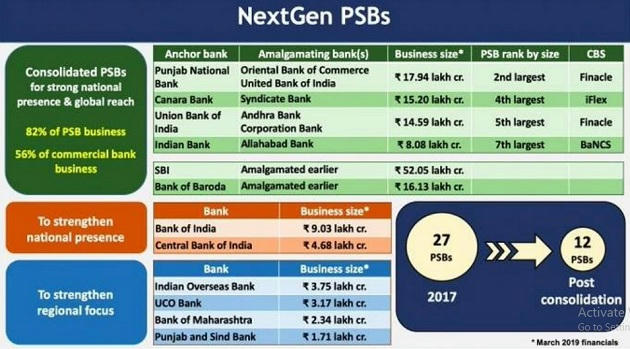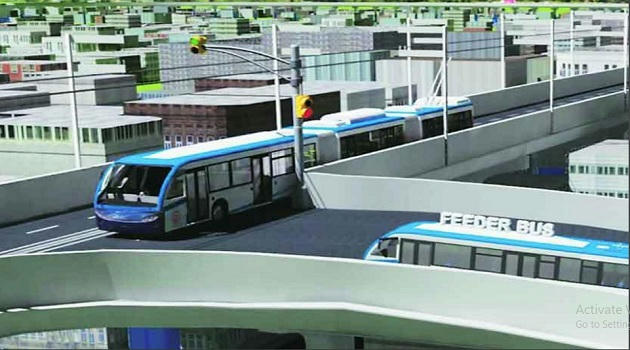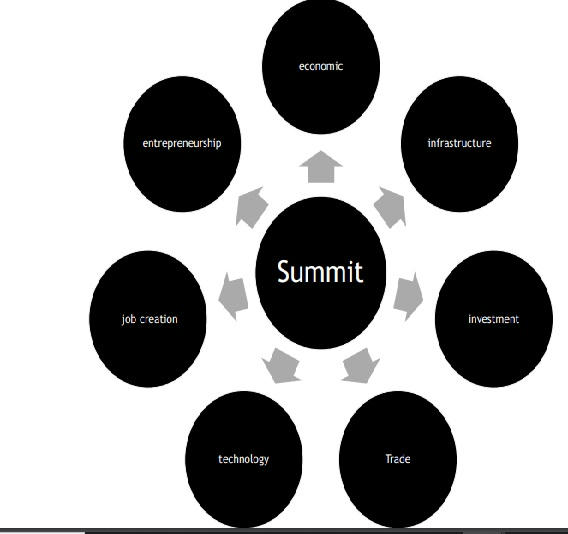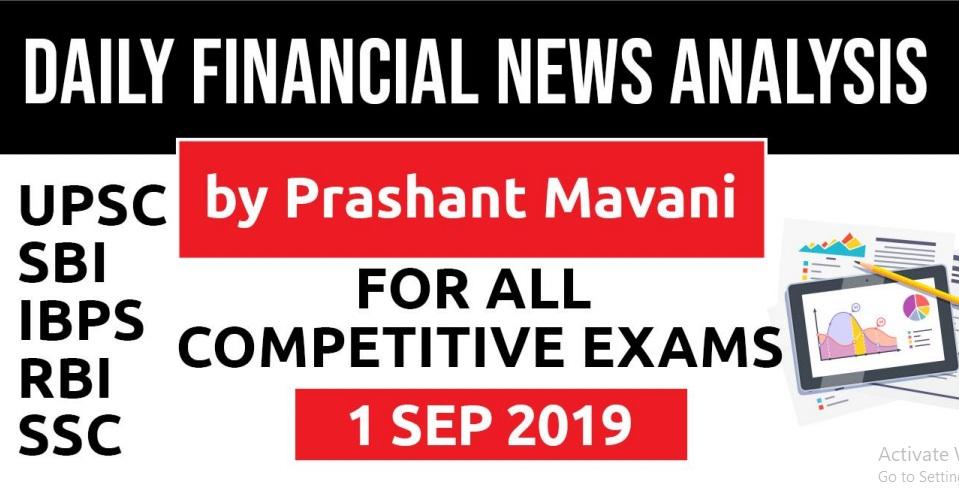Table of Contents
Mega PSB Merger
- Finance Minister Niramala Sitharaman: announced amalgamation of 10 public sector banks into four big banks.
- Upfront capital infusion: Rs 55,250 crore
- Big banks with enhanced capacity to increase credit and bigger risk appetite, with national presence and global reach.

- Sitharaman said the government is trying to create big next generation banks.
- Government’s intention not just to give capital but also give good governance.
- The consolidation will aid economies of scale for these banks, resulting in improved cost of funds and operating efficiency.
GDP Growth Slows
- India’s real gross domestic product (GDP) growth slumped to a 25-quarter low of 5% in Q1FY20.
- The slowdown is of course upon anØ unfavourable base (Q1FY19 saw 8% GDP expansion).
- Private consumption, the main engine of the economy, appears to have suffered the biggest blow with year-onyear growth of just 3.1% (the lowest since Q3FY15).
- Growth of gross value added (GVA) in manufacturing also nosedived to 0.6% in Q1FY20, compared with a rather strong 12.1% in the year-ago quarter and 3.1% in Q4FY19.
- Construction GVA grew just 5.7% in Q1FY20 versus 9.6% in the year-ago quarter.
- Investment-led revival is the government’s stated goal
CEA on Growth
- Chief Economic Adviser K V Subramanian
- Slowdown in GDP growth is due to domestic and global factors.
- Gross domestic product (GDP) data is released by the National Statistical Office.
- CEA: government is taking all steps to revive the economy and expressed confidence that the country would be on a high-growth path “very soon”.
Nashik Metro
- Maharashtra Cabinet on Wednesday approved a ₹2100-crore Nashik metro rail project.
- It will operate on electricity and battery power.
- 2 trackless elevated corridors will be developed.
- The Metro-Neo system is a unique concept being adopted for the first time in this country.
- The buses will have rubber-tyre and draw power from the overhead electric wire having 600-750 V DC supply.
State of the art buses

Building an innovation economy
- India’s economy: growing steadily despite global headwinds
- National Management Convention the All India Management Association’s annual event, aims to nudge India’s business and policy leadership towards innovation-led policies.
- Innovation spawns strong cycles of investment and consumption and gives new competitive advantages to an economy.

- If India is to nearly double its economy over the next five years, fundamental policy and business innovations are needed.
- The recent stimulus has offered temporary relief, but to achieve lasting robustness the economy needs a big dose of creativity.
- Knowledge is replacing capital and labour.
- New economy: is about value-creation and not value-extraction
- Future: companies with intellectual assets
- Most powerful global companies: innovation warriors
- Very low capital and labour intensity
- Global Innovation Index: 57/126
- ICT services exports: Rank 1
- Engineering and science graduates: Rank 6Ø
- Global R &D companies: Rank 18
- Political and business institutions: Rank 80
- Human capital and research: Rank 56
- Innovation linkages & knowledge absorption: Rank 64
- Knowledge creation and diffusion: Rank 43
- Intellectual property creation is basic to building an innovation economy.
- For every $100 billion of GDP, India has less than 200 patent applications compared to 6,000 in China.
- UN’s WIPO report 2017: India awarded 12,400 patents and 86% of those patent approvals were obtained by foreigners.
Key: reward disruptors and not the establishment
- The US, Europe, Japan, Israel and now China have become innovation powerhouses because they favour value-creators over rent-seekers.
- Silicon Valley has been a model innovation ecosystem because the start-ups can focus on creating new ways of producing and consuming things and get rich doing it.
- Government spending on basic research is critical for developing an innovation ecosystem.
- Internet, GPS, digital assistant, touchscreen were all developed with American government’s funding.
- China has become a leader in 5G, electric vehicles and digital surveillance technologies because of direct government involvement.
- The government is best-placed to invest in experimental science and technologies because of its reliable tax revenues, whereas the private sector is best placed to build commercial applications on top of basic R&D because of its efficiency.
- But it’s critical that a share of private profits from public investments are ploughed back into basic science and technology research.
- American tech giants are coming under pressure to pay more taxes and invest more in research institutions.
- Regulations and incentives play a vital role in directing innovations.
- Each generation of automobiles are cleaner and safer because of regulatory pressure.
- Solar and wind energy industries owe their development to subsidies and tax breaks.
- India can transform its education sanitation and healthcare sectors by loading incentives in favour of innovations and against inefficient technologies and operating models.
- Among emerging economies, China is a great example of rise to prosperity and power through innovation.
- India can learn from China’s deliberate increase in innovation-intensity of its economy.
- China is the only middle-income country among the 20 most innovative nations and its R&D spending and academic research are rising the fastest in the world.
- At the 2018 conference of the Association for the Advancement of Artificial Intelligence, 265 research papers of China were accepted compared to 16 from India.
- India has a serious innovation deficit and it has to make up in a rush.
- More than the fear of failure, the biggest obstacle to innovation is the idealisation of obedience and safety
Download Free PDF






















 WhatsApp
WhatsApp